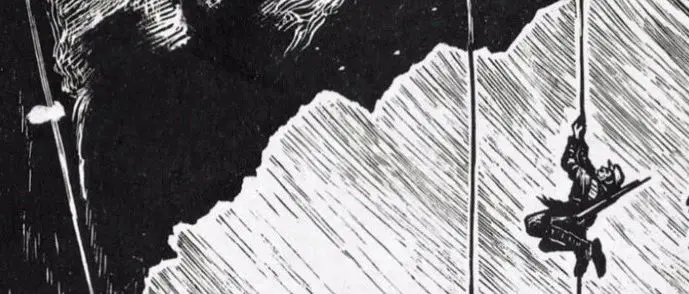The unnamed young soldier, with dozens of grenades strapped to his waist, jumped into...

"Godly Troops Descend at Lazikou, Scaling the Hundred-Foot Cliff as if on a Cloud Ladder"
The name "Lazi Kou" in Tibetan means "a perilous mountain pass and gorge," where the Red Army encountered the final formidable obstacle in their Long March.
Lazikou, located in the northeastern part of Diebu County, Gannan Tibetan Autonomous Prefecture, Gansu Province, translates from Tibetan as "the perilous mountain pass and gorge," serving as the gateway from the northwest Sichuan to Gannan. It has long been a strategic point contested by military forces. The area is flanked by towering cliffs over a hundred meters high, with a narrow pass about a meter wide in between. The Lazikou River rushes out from the gorge, making the terrain extremely hazardous and difficult to attack. At the narrowest point of the gorge, a wooden bridge becomes the sole passage, guarded by a fortress.
On the date, the Red First Front Army encountered the last major natural barrier on their Long March journey here. At that time, the enemy had deployed a heavy force to block the Red First Front Army's northward advance. Surrounded on all sides by the enemy, if the Red Army could not quickly capture the treacherous Lazikou Pass, they would face the danger of being encircled by the enemy.
On the afternoon of the day, the battle began. The Red Army launched several fierce attacks on the enemy in succession, but due to the narrow terrain, they were unable to launch large-scale assaults. The enemy, taking advantage of the terrain, used machine guns to block the single-plank bridge. When our troops approached the bridge, they threw grenades, preventing our forces from getting close to the bridgehead in several consecutive attacks. After meticulous reconnaissance, our army discovered the enemy's defensive flaws. They concentrated their main forces on the front, and the bunkers they built on the front lacked roof covers. There was also no defense set up on the tops of the cliffs on both sides.
According to the distribution of enemy forces, our army, in combination with actual conditions, decided to divide into two prongs to capture the Lazikou Pass. One prong would launch a frontal assault, while the other would stealthily circle around to the right of the Lazikou Pass, scaling the cliff wall to the rear of the enemy. Facing the steep cliff, a young Miao soldier volunteered to climb the cliff, leading the assault team to the commanding heights at the rear of the mountain. With dozens of grenades strapped to his waist, he jumped into the enemy's bunker and made the ultimate sacrifice. He left no name behind; his comrades only knew that he had enlisted in Guizhou and had traversed the three provinces of Yunnan, Guizhou, and Sichuan, affectionately calling him "Yungui Chuan."
The enemy did not expect that our army would bypass the steep cliffs to their rear, causing panic and a collapse in morale, leading them to flee in disorder. Taking advantage of the victory, our army seized the single-plank bridge and then advanced along the Lazhi River to expand the battle into the depths of the canyon, successively breaking through multiple enemy defenses, and ultimately capturing the perilous Lazhi Pass.
Standing at the present-day Lazikou, the asphalt road cuts through the canyon, turning what was once a formidable natural barrier into a tourist hotspot. Gannan is no longer a hidden paradise but one of the most popular destinations for self-driving tours. Tibetan compatriots open the gates of their villages to welcome distant guests, people gather together, enjoying happiness and joy, marching towards the future in rhythm with the times.
The great Long March spirit inspires the Chinese people to strive for self-improvement and continue to advance the great cause pioneered by the revolutionary predecessors.

